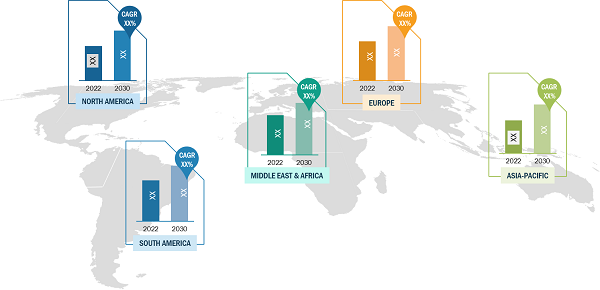Importance of Automation in Sorting and Segregation of Nuclear Waste Management
According to our latest market study on " Spent Nuclear Fuel Waste Management Market Forecast to 2030 –Global Analysis – by Reactor Type and Disposal Type," the market is expected to grow from US$ 6,124.1 million in 2022 to US$ 6,632.6 million by 2030. It is expected to fuel at a CAGR of 1.0% from 2022 to 2030.
Waste disposal in the nuclear industry requires different approaches depending on the level of radioactivity or danger. Due to the complex and unique nature of waste items, this generally requires a high level of operator involvement, from decision-making to the physical movement of the waste. Waste management can involve a range of protective equipment, from coveralls and gloves to air-fed suits. These operations carry inherent risks due to interaction with radioactive materials and other conventional risks associated with manual handling and aging infrastructure. For example, in addition to the radioactivity of dust and asbestos, decommissioning waste often also requires special control measures. It is a hot, uncomfortable, and physically demanding work environment that significantly impacts productivity.
Spent Nuclear Fuel Waste Management Market Share — by Region, 2022

Spent Nuclear Fuel Waste Management Market Analysis by 2030
Download Free SampleSpent Nuclear Fuel Waste Management Market Size and Forecast (2020–2030), Global and Regional Share, Trend, and Growth Opportunity Analysis Report Coverage: By Reactor Type (Pressurized Water Reactors (PWR), Boiling Water Reactors (BWR), and Gas-Cooled Reactors, and Others); Disposal Type (Near Surface Disposal and Deep Surface Disposal); and Geography
Source: The Insight Partners Analysis
Hence, automating nuclear waste management offers increased efficiency, safety, and cost-effectiveness. Advanced robotics and artificial intelligence (AI) systems can handle hazardous tasks, reducing human exposure to radiation and minimizing the risk of accidents during waste handling. For instance, in the Fukushima Daiichi nuclear disaster case in 2011, robots were employed to access areas that were considered dangerous for humans, thereby aiding in cleanup efforts. Automated systems can also optimize waste processing, ensuring precise sorting and disposal, which is crucial in minimizing the environmental impact of nuclear waste. With the implementation of the automation of nuclear waste management, human safety is enhanced, along with accelerating the overall cleanup process, making it indispensable in dealing with radioactive materials. Thus, the rising use of automation in sorting and segregation of nuclear waste management fuels the market growth.
In the UK, 4.9 million tonnes of nuclear waste from the country's nuclear power plants remain in temporary storage - the most significant and complex environmental cleanup task in Europe. The UK government and academic community are engaged in the development of robotic solutions needed to deal with nuclear waste generated in the country. This project is being carried out under the auspices of the National Center for Nuclear Robotics, a consortium of research centers and universities such as the University of Birmingham Extreme Robotics Lab, the University of the West of England, the University of Lincoln, the University of Essex and the Lancaster University, Queen Mary University London, University of Bristol, and the University of Edinburgh. The work is carried out in a coordinated manner across several departments in order to create innovations quickly and effectively. At Essex University, researchers are focusing on developing new image-processing algorithms to help robots perform localization, mapping, and sensing tasks in nuclear environments.
Asia-Pacific spent nuclear fuel waste management market is classified into China, Japan, India, South Korea, and the Rest of Asia-Pacific. The region generated nuclear power from 148 operable nuclear reactors in 2022, with China accounting for 37.16% of the nuclear reactor share in the region, followed by Japan and South Korea. The Asia-Pacific region faces unique challenges in managing spent nuclear fuel waste due to its diverse mix of nuclear power programs and differing approaches. Many countries rely on on-site storage of spent fuel, using cooling pools or dry cask storage systems. Countries such as Japan, South Korea, India, China, and Taiwan have faced heightened scrutiny and public opposition to nuclear waste management in the wake of nuclear accidents and seismic risks. Japan, for instance, had planned to establish repositories, but these have faced setbacks and public resistance. South Korea has been exploring potential deep geological repositories, while Taiwan is considering interim storage facilities.
China, as a major nuclear power, is actively researching long-term disposal methods, including geological repositories. India is in the early stages of developing its repository plans. The Asia-Pacific region is working to address the challenges of securing and safely managing spent nuclear fuel waste while navigating complex regulatory, environmental, and public engagement issues to ensure the long-term safety of these materials.
Augean Plc, Perma-Fix Environmental Services, Inc., Svensk Kärnbränslehantering AB, Ansaldo Energia, US Ecology, Inc., Veolia Environmental Services, Bechtel Corporation, EnergySolutions, BHI Energy, and Waste Control Specialists, LLC are among the key Spent Nuclear Fuel Waste Management Market players profiled during this study. In addition, several other important Spent Nuclear Fuel Waste Management Market players have been studied and analyzed during the study to get a holistic view of the Spent Nuclear Fuel Waste Management Market and its ecosystem.
Contact Us
Contact Person: Sameer Joshi
Phone: +1-646-491-9876
Email Id: sales@theinsightpartners.com